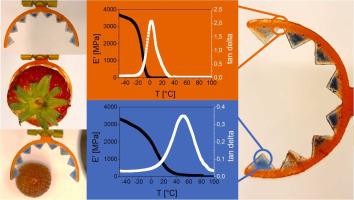Additive Manufacturing ( IF 10.3 ) Pub Date : 2023-12-20 , DOI: 10.1016/j.addma.2023.103930 Usman Shaukat , Andreas Thalhamer , Elisabeth Rossegger , Sandra Schlögl

|
Herein, the processing of multi-material vitrimers with heterogenous properties along their x-,y- and z-axis is demonstrated using dual-vat digital light processing (DLP) 3D printing. The printer is based on a conventional vat exchange set-up containing two vats and a cleaning station, which are positioned on a linearly moving platform, and are exchanged automatically during the layer-by-layer build-up of the object. Two thiol-acrylate resins are selected bearing ample -OH and ester moieties, which undergo thermo-activated transesterification in the presence of an organic phosphate as catalyst. Based on the functionality of the acrylate monomers, printing of multi-material structures with flexible (σ = 1.1 MPa, ε = 14.0%) and rigid (σ = 33.3 MPa, ε = 4.4%) domains is feasible. A good interlayer adhesion between the soft and hard domains is evidenced by uniaxial tensile tests, whilst optical microscopy is used to study the interface. Dynamic mechanical analysis further shows that the stiffness of the photopolymers varies over several orders of magnitude (E’23 °C = 209 kPa - 507 MPa). Jacobs working curves of the two different resins reveal comparable printing parameters at higher exposure doses, which do not only facilitate the printing of multiple materials between individual layers (z-heterogeneity) but also within the same layer (x,y-heterogeneity). This is confirmed by the printing of a multi-material gripper as “proof of concept” demonstrator, which contains soft inner teeth and a stiff outer core. Gripping and releasing of objects is shown by exploiting the glass transition-based shape memory properties of the stiff domains. Moreover, due to the dynamic nature of the covalent bonds, damages inserted into the gripper are intrinsically repairable due to a thermo-activated macroscopic reflow. Shape memory experiments further confirmed that the multi-material gripper fully regains its function after the thermal mending process. Thus, the results clearly show that objects with a high degree of functionality can be realized by combining multi-material 3D printing with the chemistry of vitrimers. This is of particular interest for future soft robotic applications and for mimicking biological composite structures.
中文翻译:

玻璃体的双槽光聚合 3D 打印
在此,使用双槽数字光处理 (DLP) 3D 打印演示了沿 x、y 和 z 轴具有异质特性的多材料 vitrimer 的加工。该打印机基于传统的槽交换装置,包含两个槽和一个清洁站,它们位于线性移动平台上,并在物体的逐层构建过程中自动交换。选择带有充足的-OH和酯部分的两种硫醇丙烯酸酯树脂,它们在有机磷酸酯作为催化剂的存在下进行热活化酯交换反应基于丙烯酸酯单体的功能,打印具有柔性( σ = 1.1 MPa,ε =14.0%)和刚性(σ = 33.3 MPa,ε = 4.4%)域的多材料结构是可行的。单轴拉伸测试证明软域和硬域之间具有良好的层间粘合力,同时使用光学显微镜研究界面。动态机械分析进一步表明,光聚合物的刚度变化了几个数量级(E'23 °C = 209 kPa - 507 MPa)。两种不同树脂的 Jacobs 工作曲线揭示了在较高曝光剂量下可比较的打印参数,这不仅有利于在各层之间(z 异质性)而且在同一层内(x,y 异质性)打印多种材料。作为“概念验证”演示器的多材料夹具的打印证实了这一点,该演示器包含柔软的内齿和坚硬的外芯。通过利用刚性域基于玻璃化转变的形状记忆特性来显示物体的抓取和释放。此外,由于共价键的动态性质,插入夹具中的损坏本质上是可以通过热激活宏观回流来修复的。形状记忆实验进一步证实,多材料夹具在热修复过程后完全恢复其功能。因此,结果清楚地表明,通过将多材料 3D 打印与玻璃体化学相结合,可以实现具有高度功能性的物体。这对于未来的软机器人应用和模仿生物复合结构特别有意义。












































 京公网安备 11010802027423号
京公网安备 11010802027423号